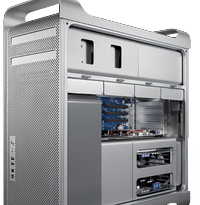Business
Up and downs of the new Mac mini, long live the new Mac Pro
According to readers, the Mac mini appears to be their new Mac best friend. Despite the upbeat words, there are better choices in Apple's revised Mac lineup.


Mac Minis today have the horsepower of Mac Pros of a few years ago and the requirements for [Adobe] Photoshop, Illustrator etc. hasn't increased much.While some bits of that thesis may be true, few graphics pros will want the Mac mini for actual work. It's underpowered and doesn't support enough memory (2GB). The alternate, lower-cost choice for some graphics pros may be the new 3GHz iMac, which can support 4GB of RAM and in its standard config comes a terabyte hard drive, and the NVIDIA GeForce GT 130 (512MB). Still, the machine in Apple's recently revised lineup that is a leap forward is the new Mac Pro. What a user-friendly design: side-out bays for 4TB of storage, easy access to memory slots and the CPU with a slide-out tray. Apple says that the Mac Pro is a "beauty on the outside; beast inside." It's also a beauty on the inside. Joel Ingulsrud, a former colleague from my days in the color-calibrated monitor business, pointed out that the Mac Pro's use of a thumbscrew bracket for PCI Express 2.0 cards, make it the first tool-less expansion card cage since the demise of NuBus. (BTW: I loved NuBus: expansion cards could be locked in solid to the logic board without any tools. PCI was a big step down in the reliability department. Joel's comment puts me nostalgic for my favorite NuBus machine: the ancient Mac IIci. It also could be opened up easily with a couple of clips and was one of my all-time favorite Mac designs.) "From a lifespan perspective, the 8-core Mac Pro will still be a viable workstation ten years from now. I haven't seen an architectural leap that solid from Apple's pro lineup since the post-Yikes G4s," he said. I totally agree. The Mac Pro will hold its value and offer useful performance for many many years. A keeper.